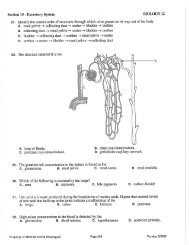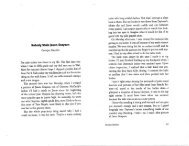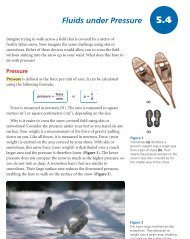The Minnesota Twin Study[1].pdf
The Minnesota Twin Study[1].pdf
The Minnesota Twin Study[1].pdf
You also want an ePaper? Increase the reach of your titles
YUMPU automatically turns print PDFs into web optimized ePapers that Google loves.
<strong>The</strong> <strong>Minnesota</strong> <strong>Twin</strong> <strong>Study</strong><br />
<strong>The</strong> study, directed by Thomas J. Bouchard, began in 1979 and involved a week-long medical<br />
and psychological assessment of identical and fraternal twins separated in early life and reared<br />
apart. <strong>The</strong> psychological assessment included multiple measures of personality, mental abilities,<br />
values, interests, psychomotor skills, reading, spelling, and writing. <strong>The</strong> medical assessment<br />
involved a psychiatric interview, a medical life history, a standard blood battery, and even<br />
detailed dental and periodontal exams. This massive study provides many examples of separated<br />
identical twins showing remarkable similarities.<br />
Separated as infants, twins Gerald (Jerry Levey) and Mark Newman grew up to share<br />
characteristics ranging from their firefighting avocation to taste in beer. Neither know of the<br />
other’s existence until a shared acquaintance brought them together. Upon meeting for the first<br />
time each saw his own reflection. <strong>The</strong>y had grown the same mustache and sideburns, and each<br />
wore the same glasses. As the brothers talked, they discovered they had more than looks in<br />
common. Levey went to college and graduated with a degree in forestry. Newman planned to<br />
go to college to study the same subject but opted to work for the city trimming trees. Both<br />
worked for a time in supermarkets. Levey had a job installing sprinkler systems. Until relatively<br />
recently, Newman had a job installing fire alarms. Both men are bachelors attracted to similar<br />
women – “tall, slender, long hair.” In addition to being volunteer firefighters, they both share<br />
favorite pastimes of hunting, fishing, going to the beach, watching old John Wayne movies and<br />
pro wrestling, and eating Chinese food in the wee hours after a night on the town. Both were<br />
raised in the Jewish faith but neither is particularly religious. Both men drink only Budweiser<br />
beer, holding the can with one pinkie curled underneath and crushing the can when it’s empty.<br />
In becoming acquainted, observes Jerry, “we kept making the same remarks at the same time and<br />
using the same gestures. It was spooky…He is he and I am I, and we are one.”<br />
<strong>The</strong> twins in the <strong>Minnesota</strong> study completed a number of interviews and tests. Thomas<br />
Bouchard and his colleagues reported that heredity accounted for 64 to 74 percent of the<br />
differences seen in IQ between the identical twins. Previous studies found that heredity<br />
explained 47 to 58 percent of the variance. <strong>The</strong> Multidimensional Personality Questionnaire<br />
(MPQ) evaluated the twins for impulsiveness, aggressiveness, need for achievement,<br />
traditionalism, stress reaction, sense of well-being, social potency (including traits such as<br />
leadership), social closeness, alienation, harm avoidance, and absorption, or “proneness to<br />
imaginative activities.” In each of these areas researchers found heritability of about one-half.<br />
<strong>The</strong> figures ranged from 39 percent for achievement to 55 percent for harm avoidance. <strong>The</strong><br />
researchers emphasize that the significance of the findings is that heritabilities were found at all.<br />
More surprising is that they all hovered at about 50 percent.<br />
Clearly, the <strong>Minnesota</strong> study does not provide perfect assessment of heredity’s<br />
contribution to our traits (including intelligence) and has led to some questions about the<br />
reliability of twin studies. For example, separated identical twins shared the same prenatal<br />
environment. If those nine months are crucial in determining how the brain is wired,<br />
environment is already having a significant impact before birth. This would also help explain<br />
why fraternal twins (who are no more alike genetically than any brother and sister) have IQs<br />
more alike than ordinary siblings. Moreover, separated identical twins are rarely separated at the<br />
moment of birth. <strong>The</strong> twins in the <strong>Minnesota</strong> study had on average 5 months together before<br />
they were separated. If the first 6 months of life are indeed important, environment could still be<br />
contributing to their similar personality traits. Finally, after their reunion, the twins averaged
nearly two years together before they participated in the study. Naturally, the researchers paid<br />
special attention to their similarities and may, as some critics have argued, have come to<br />
“mythologize” the twins’ relationship.<br />
Adler, T. (1991, January). Seeing double? APA Monitor, 1, 8.<br />
Happiness is a reunited set of twins. (1987, April 13). U.S. News & World Report, 63-66.<br />
Rosen, C.M. (1987, September). <strong>The</strong> eerie world of reunited twins. Discover, 36-46.<br />
What we learn from twins. (1998, January 3). <strong>The</strong> Economist, 74-76.


![The Minnesota Twin Study[1].pdf](https://img.yumpu.com/11644225/1/500x640/the-minnesota-twin-study1pdf.jpg)






